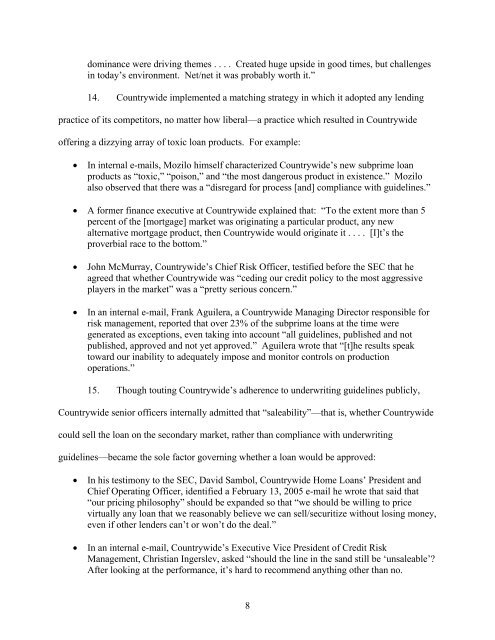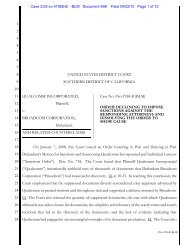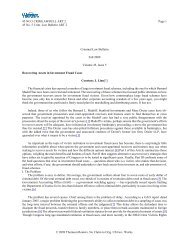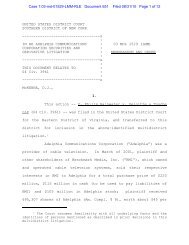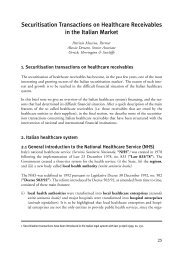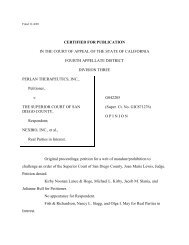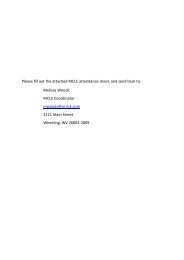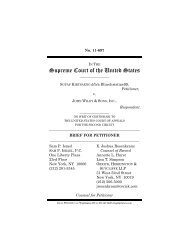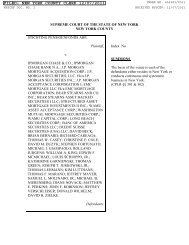SUPREME COURT OF THE STATE OF NEW ... - New York Times
SUPREME COURT OF THE STATE OF NEW ... - New York Times
SUPREME COURT OF THE STATE OF NEW ... - New York Times
You also want an ePaper? Increase the reach of your titles
YUMPU automatically turns print PDFs into web optimized ePapers that Google loves.
dominance were driving themes . . . . Created huge upside in good times, but challenges<br />
in today’s environment. Net/net it was probably worth it.”<br />
14. Countrywide implemented a matching strategy in which it adopted any lending<br />
practice of its competitors, no matter how liberal—a practice which resulted in Countrywide<br />
offering a dizzying array of toxic loan products. For example:<br />
• In internal e-mails, Mozilo himself characterized Countrywide’s new subprime loan<br />
products as “toxic,” “poison,” and “the most dangerous product in existence.” Mozilo<br />
also observed that there was a “disregard for process [and] compliance with guidelines.”<br />
• A former finance executive at Countrywide explained that: “To the extent more than 5<br />
percent of the [mortgage] market was originating a particular product, any new<br />
alternative mortgage product, then Countrywide would originate it . . . . [I]t’s the<br />
proverbial race to the bottom.”<br />
• John McMurray, Countrywide’s Chief Risk Officer, testified before the SEC that he<br />
agreed that whether Countrywide was “ceding our credit policy to the most aggressive<br />
players in the market” was a “pretty serious concern.”<br />
• In an internal e-mail, Frank Aguilera, a Countrywide Managing Director responsible for<br />
risk management, reported that over 23% of the subprime loans at the time were<br />
generated as exceptions, even taking into account “all guidelines, published and not<br />
published, approved and not yet approved.” Aguilera wrote that “[t]he results speak<br />
toward our inability to adequately impose and monitor controls on production<br />
operations.”<br />
15. Though touting Countrywide’s adherence to underwriting guidelines publicly,<br />
Countrywide senior officers internally admitted that “saleability”—that is, whether Countrywide<br />
could sell the loan on the secondary market, rather than compliance with underwriting<br />
guidelines—became the sole factor governing whether a loan would be approved:<br />
• In his testimony to the SEC, David Sambol, Countrywide Home Loans’ President and<br />
Chief Operating Officer, identified a February 13, 2005 e-mail he wrote that said that<br />
“our pricing philosophy” should be expanded so that “we should be willing to price<br />
virtually any loan that we reasonably believe we can sell/securitize without losing money,<br />
even if other lenders can’t or won’t do the deal.”<br />
• In an internal e-mail, Countrywide’s Executive Vice President of Credit Risk<br />
Management, Christian Ingerslev, asked “should the line in the sand still be ‘unsaleable’?<br />
After looking at the performance, it’s hard to recommend anything other than no.<br />
8


